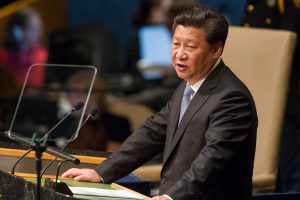Two years after the Paris Agreement and the focus of this year’s climate talks will be on how to plug the gap in green financing, how countries can scale up their national contributions to climate action, and the rights of island states facing rising seas and more extreme weather. So given these various needs, expectations, and the resources of the 190 countries represented, what outcomes will constitute success and failure at COP23?
Teng Fei, associate professor, Institute of Energy, Environment, and Economy, Tsinghua University
The main task at this year’s COP is to set out the detailed rules on how the Paris Agreement will be implemented – it won’t be a big year. But the devil is often in the detail – they may be small things, but they will determine whether or not the Paris Agreement achieves its long term goals. I don’t think we’ll be able to say whether those rules have been successful or not this year, or for several years to come.
The most obvious criteria is whether or not the various parties manage to decide on those rules according to the already-agreed timetable, but I think the quality of the rules is more important than the schedule. Only when the rules are implemented will we be better able to judge whether or not the mechanisms under discussion can realise the Paris goals.
As 80% of the outcomes are decided in advance, each country brings its own stance to the negotiations, and once they’ve taken that stance there’s limited room for negotiation. Those positions are determined by domestic politics, and unless domestic politics change the positions won’t change, so there’s no chance of significant change at one negotiating session. The lesson of the Paris Agreement was the selection of a bottom-up approach to solving problems, and we should look for solutions and responses to climate change which are rooted in the everyday lives of the public, rather than relying on the political elite or on negotiations alone.
Yang Fuqiang, senior advisor on climate and energy, National Resource Defence Council
We should see a fairly modest outcome from this year’s climate talks, as we can’t expect everyone to have decided on the rules for implementing the Paris Agreement in a single year. This is only the beginning. And some of the details are tricky – for example this year’s chair, Fiji, lacks influence and if we don’t see a positive approach from major powers, progress is unlikely. This year we also need to look to key European nations such as Germany, the UK and Denmark – will they join with China to put forward new initiatives and actions? If so, that may give rise to a small flurry.
The attitude of the US continues to be an issue this year. Trump has said the US will withdraw from the Paris Agreement, but a formal withdrawal won’t be possible until 2022, and the US still has the right to intervene on a lot of matters and may present an obstacle to negotiations – for example, on funding and technology.
This restriction also provides the United States with the opportunity to interfere with the many issues and to create barriers to negotiations, particularly on issues such as capital, technology, capacity building and ambitions.
Monique Barbut, under-secretary general and executive secretary, United Nations Convention to Combat Desertification
The Paris Agreement achieved consensus on limiting the rise in temperature to below 2 degrees Celsius. For some regions in Africa, this would still lead to a 4-degree temperature rise, on average, causing epic scale disasters and unimaginable human suffering. For COP23 to be successful, adaptation must now be given the same sense of urgency and be put on the same footing as mitigation efforts. Any new mechanisms emerging should ensure that the most vulnerable countries can adapt and avoid the most catastrophic scenarios.
The Agreement has four times the potential of the Kyoto Protocol to eliminate greenhouse gases. A lot of these new mitigation actions are based on land use and land use change. A successful COP23 needs to develop comprehensive systems that can effectively guide and promote action in this area, for at least three reasons.
First, we know a lot more today about assessing soil-based measures than we did two decades ago. Under the Kyoto Protocol, for instance, carbon emissions through land use change and carbon sequestration through forests were taken into account, even if not fully understood. But limiting action under the Paris Agreement to these two areas would amount to failure.
Under the desertification process, we have made a lot of progress in developing measures to assess land-based sequestration processes. Governments agreed on how to assess land cover change, land productivity and soil carbon sequestration, regardless of the ecosystem. From these experiences, COP23 can refine ways to assess initiatives under land use and land use change and promote synergies between the Conventions.
Second, there is often a discrepancy between what governments intend to achieve and what is actually realised. We need to ensure that every commitment – including in the new areas of land use and land use change identified under the Paris Agreement – are turned into real commitments on the ground.
Third, incentives to promote early action are vital. They would be highly effective in the context of land-related measures. On the one hand, it would shield productive land from further degradation in order to curb future emissions. On the other hand, the rehabilitation of degraded land would put carbon back into the soil.
Jennifer Morgan, executive director, Greenpeace International
As a whole, a successful COP23, including the events that occur around it, will need to show an acceleration of momentum towards the Paris Agreement goals to limit global warming to 1.5 degrees Celsius. This will require the emergence of strong, shared leadership at all levels from governments, cities, states, corporations and communities around the world towards higher ambition, to meet the worsening climate threat in the small window of opportunity we still have.
Specifically, in the US, mayors, governors and others can counterbalance President Trump’s announced withdrawal from Paris. In Europe, all eyes will be on Germany as a new government must commit to phasing out coal and the combustion engine to maintain its credibility internationally.
In the COP negotiations themselves, the list of unfinished business of the Paris Climate Agreement is long and detailed and it is crucial for significant progress to be made on the Paris Agreement’s implementation guidelines. A roadmap must emerge from the COP, clarifying the process to finalise the rulebook by the deadline in 2018. This is important to maintain momentum and to demonstrate the world is still committed to Paris.
Carlos Rittl, executive secretary, Brazilian Climate Observatory (Observatório do Clima)
Besides a good draft for the implementation guidelines of the Paris Agreement, the benchmark of success at COP23 will be how diplomats outline the 2018 “facilitative dialogue” on enhancing climate ambition. At 403 parts-per million of carbon dioxide (CO2) in the atmosphere, with 2017 temperatures heading towards a near-record high and with science saying again-and-again that NDCs (Nationally Determined Contributions) must be pumped up by 2020, if we want to avoid climate catastrophe, next year needs to deliver much more than a shop talk between the hopeless. It is crucial that a substantive conversation about a substantive increase in ambition begins now.
We are at a time when the Paris spirit may be trampled (“trumped”?) by the old North/South divide. Some developed countries would like to see further engagement of developing nations on climate action, while developing countries are still waiting to see rich nations deepen their emission cuts and put more money on the table. Negotiators should defuse this zero-sum time bomb before it explodes on our way to 2020. As a vulnerable country, the Fiji presidency is in a unique position to guide them.
Lina Barrera, senior director of international policy, Conservation International
If we want to keep the world’s climate to 1.5 degrees, then we need to act quickly and ensure that there is no delay in setting the rules for the Paris Agreement. Countries must emerge from these negotiations with significant progress on determining the rules around elements that will increase ambition and facilitate reductions in CO2 – such as updates to nationally determined contributions (NDCs) and emission trading.
In both cases nature needs to be incorporated. Nature-based solutions are critical to achieving the Paris Agreement goals. Nature can provide at least 30% of the mitigation action needed to limit global temperature rise to 1.5 degrees Celsius in addition to important adaptation benefits. Nature’s climate solutions include conservation and restoration of critical ecosystems, which are among the most immediate and cost-effective solutions available for mitigating the causes of climate change and adapting to its impacts.
Wael Hmaidan, executive director, Climate Action Network
This “Pacific COP” is the first climate talks presided over by an island state, the most vulnerable group of countries to climate change, and the champions of the 1.5-degree temperature rise limit. Therefore, it is important for COP23 to make everyone feel the true impacts of climate change and communicate urgency of action. The recent spate of climate-related disasters further brings home how national policies cannot remain tone deaf to the reality of climate impacts that jeopardise lives and jobs.







